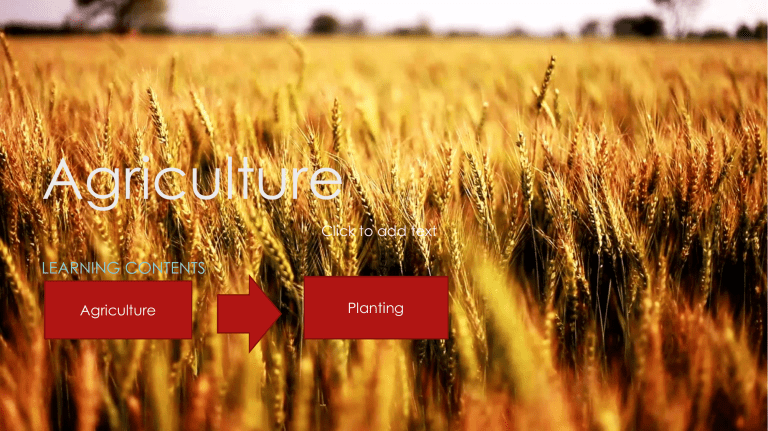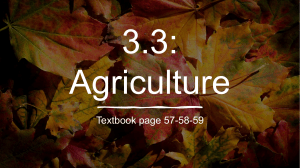
Agriculture Click to add text LEARNING CONTENTS Agriculture Planting Planting 1. Types of Plants Plants are living things that get their food from sunlight. They do not move around like animals. They are fixed to the earth. Planting is the process of putting plant seeds, bulbs, or sprouts in soil to allow them to grow up. There are two main groups of plants – garden plants and crop plants. Garden plants are plants that people take care of in their gardens. They need to be taken care of by having the soil prepared, being fertilsed, watered, weeded, ensuring they are free of pests. Garden plants can be put into flowering plants and foliage plants. This Photo by Unknown author is licensed under CC BY-SA-NC. Fruit plants Fruit plants are grown so we can harvest their fruit. They are usually long-lived perennial plants like mangoes, rambutans, tangerines, pomelos, durians, and mangosteens. This Photo by Unknown author is licensed under CC BY-SA-NC. 2. Flowering plants FLOWERING PLANTS PROVIDE BEAUTIFUL AND COLOURFUL FLOWERS WHICH ARE USED TO DECORATE SPACES SUCH AS GARDENS, PARKS, AND HOUSES. SOME HAVE A NICE SMELL. FOR EXAMPLE, ROSES, MARIGOLDS, AND ORCHIDS. 3. Foliage Plants Foliage plants are those plants that are grown because they have a nice shape or have colourful stems or leaves. These plants and shrubs include different types of ferns, palms, and bamboos. Vegetable Plants Vegetable plants are plants that are grown so we can eat various parts of the plant, such as the roots, stems, leaves, or bulbs. Most vegetables are seasonal and grow quickly, but do not last long, such as lettuce, kale, morning glory, cucumbers, and pumpkins. There are also perennial vegetable plants like stink bean, acacia, sauropods, and bergamot. This Photo by Unknown author is licensed under CC BY. Crop plants Crop plants are fast growing plants that are grown on a large scale. They require less care than garden plants. Most grow for two to twelve months. They are an important economic resource and are locally or overseas. They include rice, corn, sugarcane, beans, cotton and cassava. 1. Planting There are different ways for plants to be grown. Usually they are grown in soil because of the ease of planting and caring for them. They can be grown in large areas of soil or in pots. They can also be grown in water – hydroponics. This Photo by Unknown author is licensed under CC BY-SA-NC. Procedures for growing plants in soil. Selecting seeds or other parts of the plants to be planted. Seeds should be taken from full healthy pods. They shouldn't be too old, or too young. They need to be healthy and free from disease and be free from insect damage. Cuttings should be the right age. They need to be healthy and strong and without signs of damage from disease or insects. Other parts of a plant such tubers or roots also need to be strong and healthy. They need to free from disease and damage from insects. This Photo by Unknown author is licensed under CC BY-SA. 2. Soil Preparation 1 unit of loose soil 1 unit of compost 1 unit of manure is the process of getting the soil ready for planting to enable plants to grow quickly and provide good products. Different areas have different types of soil. This needs to be taken into consideration when preparing the soil for planting. It will determine how much manure or other type of preparation needs. Planting is the procedure where seeds, cuttings, or other parts of plants are placed in the prepared soil. The method of planting will vary according to what is being planted. Some seeds can be scattered, and others can be buried at certain depths. This Photo by Unknown author is licensed under CC BY-SA-NC. Caring for the plants as they grow. They will need water, fertilizer, and weeding. Watering needs to be exact. Not too much water or the roots will rot, and not too little, or they will die. The amount depends on the crop that has been planted and the soil it has been planted in. Hoeing is the process of loosening the soil around a plant's roots with a hoe so they can absorb water and nutrients. A trowel can be used for smaller plots. Fertilizing is the process of supplying the plants with the food they require. The type will depend on the plant. It comes in a dry mix, or some are liquid-based. This Photo by Unknown author is licensed under CC BY-SA-NC. Weeding is done to remove the competition for nutrients and water. It can be done by hand, machines, or with chemicals. It should be done before fertilizing to enable the crop to gain the most from it. Pesticides are chemicals that are used to remove pests to prevent them from damaging the plants. Herb extracts can sometimes be used. It is also possible to remove some pests by hand. This Photo by Unknown author is licensed under CC BY-SA-NC. Harvesting is the process of collecting the crop grown. There are various methods of harvesting, and it is dependent on the crop being harvested. Harvesting by hand may be done with herbs. Harvesting with small tools may be done with small plots. Harvesting with machinery may be done on larger plots. This Photo by Unknown author is licensed under CC BY-SA. Hydroponics is a relatively new way of growing plants without the need for soil. It requires less insecticide and less pesticide so it is better for the environment and possibly better for human consumption. It is an efficient method of water utilization and requires minimum fertilization. This Photo by Unknown author is licensed under CC BY.


